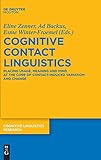Cognitive Contact Linguistics : Placing Usage, Meaning and Mind at the Core of Contact-Induced Variation and Change / ed. by Eline Zenner, Ad Backus, Esme Winter-Froemel.
Material type: TextSeries: Cognitive Linguistics Research [CLR] ; 62Publisher: Berlin ; Boston : De Gruyter Mouton, [2018]Copyright date: ©2019Description: 1 online resource (VI, 342 p.)Content type:
TextSeries: Cognitive Linguistics Research [CLR] ; 62Publisher: Berlin ; Boston : De Gruyter Mouton, [2018]Copyright date: ©2019Description: 1 online resource (VI, 342 p.)Content type: - 9783110616781
- 9783110616842
- 9783110619430
- 400
- online - DeGruyter
- Issued also in print.
| Item type | Current library | Call number | URL | Status | Notes | Barcode | |
|---|---|---|---|---|---|---|---|
 eBook
eBook
|
Biblioteca "Angelicum" Pont. Univ. S.Tommaso d'Aquino Nuvola online | online - DeGruyter (Browse shelf(Opens below)) | Online access | Not for loan (Accesso limitato) | Accesso per gli utenti autorizzati / Access for authorized users | (dgr)9783110619430 |
Browsing Biblioteca "Angelicum" Pont. Univ. S.Tommaso d'Aquino shelves, Shelving location: Nuvola online Close shelf browser (Hides shelf browser)
Frontmatter -- Contents -- Introduction: Placing usage, meaning and mind at the core of contact-induced variation and change -- Part I: Conceptual foundations and categorization principles in contact-induced change -- 1. Reconceptualizing language contact phenomena as cognitive processes -- 2. English-Estonian code-copying in blogs: Combining a contact linguistic and cognitive approach -- 3. Reanalysis in language contact: Perceptive ambiguity, salience, and catachrestic reinterpretation -- 4. When third-wave sociolinguistics and prototype analysis meet: The social meaning of sibilant palatalization in a Flemish Urban Vernacular -- Part II: Associating concepts: Metaphors and cultural models in contact -- 5. Notions of Containment and Support in Irish English: Implications of language contact on the cognition of space -- 6. Conceptual metaphors as contact phenomena? The influence of local concepts on source and target domain -- 7. Cultural models in contact: Revealing attitudes toward regional varieties of Italian with Vector Space Models -- Part III: Construction Grammar: Contact in and through more and less schematic form-meaning pairs -- 8. Language alternation and the state-event contrast: A case-study of Dutch-Turkish and Dutch-Moroccan heritage speakers -- 9. Partially schematic constructions as engines of development: Evidence from German-English bilingual acquisition -- 10. Constructional renovation: The role of French legal language in the survival of the nominative-and-infinitive in Dutch -- Index
restricted access online access with authorization star
http://purl.org/coar/access_right/c_16ec
This volume serves to illustrate the promising insights to be gained when cross-fertilizing Cognitive Linguistics and contact linguistics, which each hold crucial ingredients to an encompassing study of contact-induced variation and change. Combining the study of the individual mind with the study of shared context, bridging research on experience and perspective with research on variation and change, and tackling the methodological complexities that this empirical approach to mental categorization entails, help us determine how the meaningful units that make up language are categorized and structured in the bi- and multilingual mind and, by extension, in any human mind. Together, the ten papers in this volume reveal the complexities of the interaction between usage, meaning and mind in contact-induced variation and change, which we hope will inspire future research exploring the possibilities of the cross-fertilization we have labeled Cognitive Contact Linguistics.
Issued also in print.
Mode of access: Internet via World Wide Web.
In English.
Description based on online resource; title from PDF title page (publisher's Web site, viewed 25. Jun 2024)









